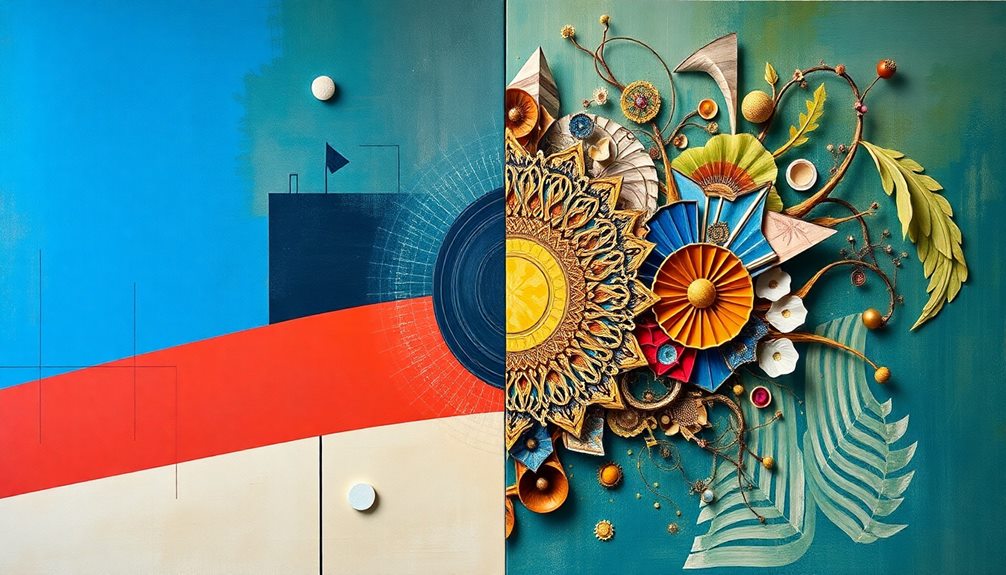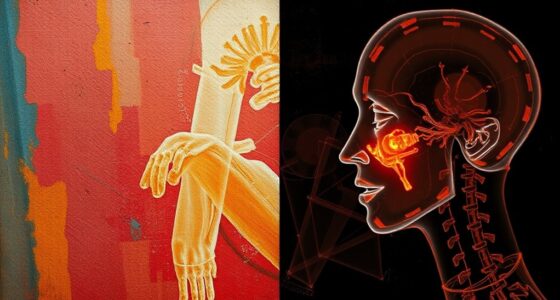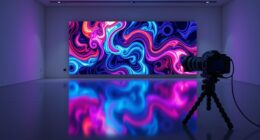To analyze brushwork, start by focusing on the techniques used. Notice if the strokes are fluid, jagged, or harsh, as each conveys different emotions. Examine color interactions, like how warm colors can energize while cool ones promote calmness. Pay attention to the composition and flow, considering how the brushstrokes guide your gaze. Finally, think about the artist's intent; the brushwork can reveal their emotional state and message. These elements not only enhance your understanding but also deepen your connection to the artwork. Keep exploring to uncover even more insights into the artistry behind brushwork.
Key Takeaways
- Observe the type of brushstrokes used; fluid strokes suggest calmness while jagged strokes indicate conflict or distress.
- Analyze color interactions; note how complementary colors enhance energy and how warm or cool colors influence emotional responses.
- Examine the composition and flow; consider how the arrangement and rhythm of strokes guide the viewer's gaze and narrative.
- Reflect on the emotional impact of the brushwork; different strokes evoke unique feelings and can reveal the artist's emotional state.
- Investigate the artist's intent; context and technique provide insights into the message and personal connections within the artwork.
Understanding Brushstroke Techniques

Understanding brushstroke techniques is essential for interpreting the emotional and narrative layers of a painting. When you analyze art, pay close attention to the fluidity or jaggedness of the strokes. Fluid brushstrokes often convey smoothness and calm, while jagged strokes can reflect inner turmoil or conflict. This contrast in technique reveals the emotional state of the artist at that moment.
Harsh brushstrokes can signify intense feelings—whether joyful or painful—and create a striking visual impact. If you notice short, quick strokes, they often imply urgency or agitation. In contrast, long, delicate strokes typically evoke tranquility and softness.
As you explore the use of color in conjunction with these brushstroke techniques, consider how they interact to enhance the overall message of the artwork. Variations in brushstroke styles across different artists can also reveal unique techniques, contributing to their individual expressions.
Emotional Impact of Brushwork

The emotional impact of brushwork plays a critical role in how you perceive and connect with a painting. Different brushstroke types create distinct feelings, shaping your experience of the artwork. For instance, fluid strokes often evoke calmness and serenity, inviting you to linger in the moment.
In contrast, jagged strokes may suggest distress or conflict, prompting a visceral reaction that can be unsettling yet compelling. You'll notice that harsh brushstrokes can symbolize intensity and passion, resonating deeply with your own feelings.
This emotional response varies among viewers, emphasizing the subjective nature of art interpretation. As you analyze the context and variation of brushstrokes, you gain insight into the artist's intent and the narrative they convey.
The interplay of brushstroke techniques not only showcases the artist's skill but also reflects their personal journey and emotional release. By celebrating individuality through brushwork, artists invite you to explore your own emotions, creating a powerful connection to the piece.
Analyzing Color Interactions

When analyzing color interactions in brushwork, you'll find that these elements can greatly enhance the painting's depth and visual appeal. The use of complementary colors is particularly powerful; they create stark contrasts that draw your eye and energize the overall composition.
For example, placing a vibrant orange next to a deep blue can produce dynamic visual effects that keep you engaged.
Pay attention to the temperature of colors as well. Warm colors often evoke energy and excitement, while cool colors can instill a sense of calmness. This interplay can greatly influence your emotional response to the artwork.
Don't overlook color value, which refers to the lightness or darkness of a color. Understanding this concept helps you see how brushwork establishes contrast and focal points within the painting.
Exploring Composition and Flow

Examining composition and flow in brushwork reveals how artists guide your gaze and create an emotional experience. When you study a painting, pay attention to the arrangement of elements; this composition is essential for establishing a harmonious flow throughout the artwork. Notice how the direction and rhythm of brushstrokes lead your eye from one focal point to another.
Different types of brushstrokes—ranging from detailed to broader strokes—play a significant role in achieving balance and unity. Variations in brushstroke size and intensity can enhance visual shifts, creating a sense of movement or stillness. For instance, swift, energetic strokes can evoke feelings of chaos, while smooth, gentle strokes may convey tranquility.
As you analyze the flow of brushwork, consider how these elements interact with each other. The interplay between detailed and broader strokes contributes to the overall narrative, influencing how different areas relate.
Artist's Intent and Interpretation

Understanding an artist's intent and interpretation through their brushwork can reveal a deeper connection to the artwork. By analyzing the strokes, you can uncover the emotional state of the artist, as their choices often reflect their inner experiences. Different techniques can convey various feelings, providing a window into the narrative behind the piece.
Here are four aspects to reflect upon when interpreting brushwork:
- Type of Strokes: Notice whether the strokes are fluid or jagged. Fluid strokes often suggest calmness, while jagged strokes may indicate turmoil or tension.
- Texture and Variation: Examine the texture and variation in brushwork. These elements highlight the artist's unique style and skill, enhancing your appreciation of their artistic vision.
- Context: Consider the context in which the brushstrokes are used. This can provide crucial insight into the story or message the artist aims to communicate.
- Emotional Implications: Reflect on the emotional implications of the brushwork. Recognizing these can foster a personal connection with the artwork, leading to a richer understanding of the artist's intent.
Embracing these elements enriches your interpretation and appreciation of the art.
Frequently Asked Questions
How Would You Describe Brushwork in Art?
You'd describe brushwork as the artist's unique technique, conveying emotions through varying strokes. Fluid movements evoke tranquility while jagged lines suggest conflict, revealing the depth of feeling and intent behind the artwork's surface.
How to Do an Analysis of an Artwork?
Did you know that 75% of art viewers focus on the first impression? Start your analysis by examining composition, color, and textures, then dive deeper into the artist's intent and emotional expression throughout the piece.
What Are the 5 Basic Brush Strokes?
You'll find five basic brush strokes: fluid for smoothness, jagged for conflict, harsh for strong emotions, quick for urgency, and long delicate strokes for ethereal softness. Each evokes distinct feelings in your artwork.
How Do You Describe Brush Strokes in Art?
Did you know that artists often use over 20 different brush strokes in a single piece? To describe brush strokes in art, focus on their type, direction, and texture, revealing the artist's emotion and intent.
Conclusion
In analyzing brushwork, you're not just looking at paint on canvas; you're diving into the soul of the artwork. Each stroke tells a story, revealing the artist's emotions and intentions. By understanding techniques, color interactions, and composition, you can see the bigger picture. So, don't just scratch the surface—go deeper. Embrace the nuances, and you'll find that every brushstroke is a window into the artist's mind, allowing you to appreciate the art in a whole new light.









